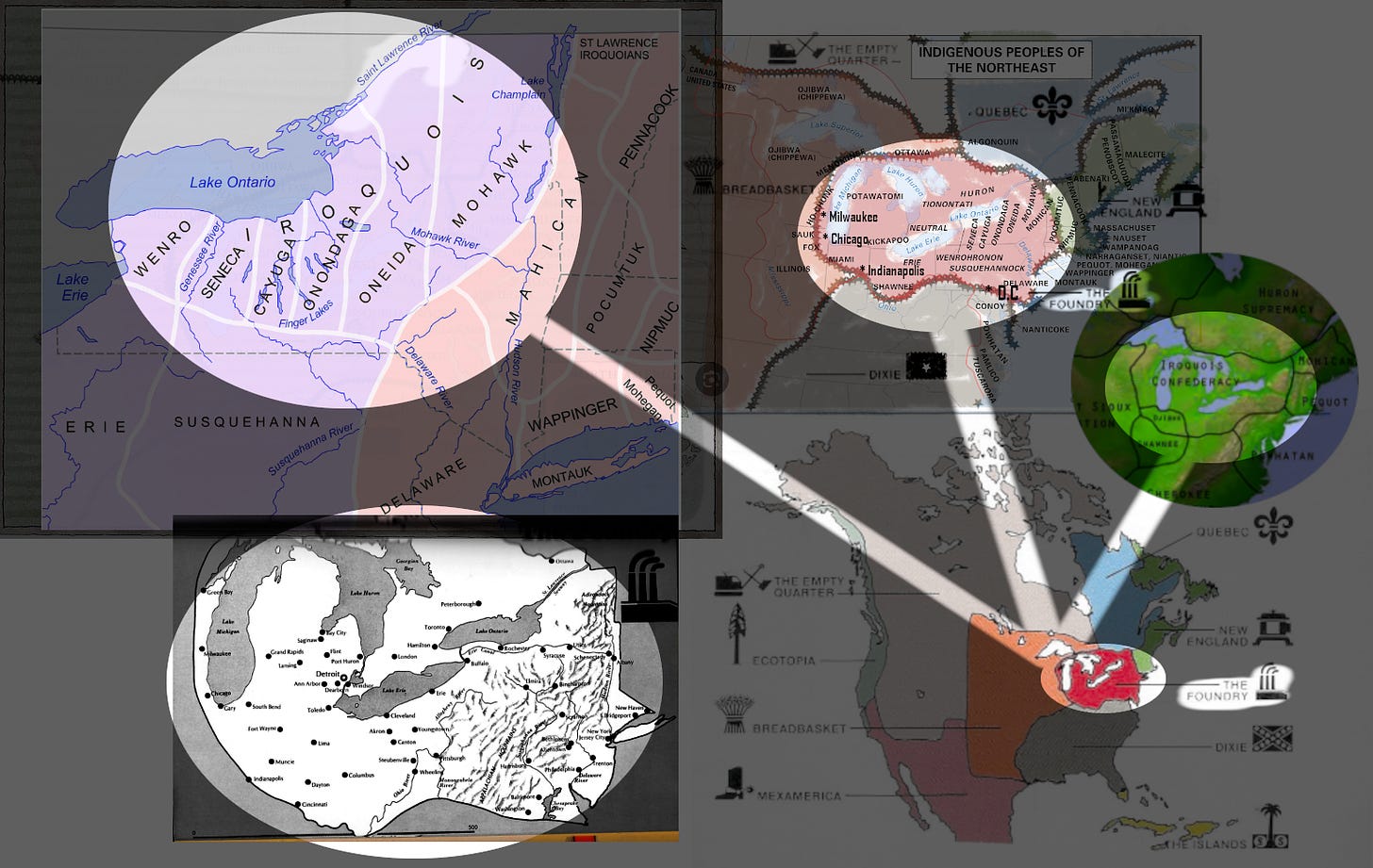Its capital must be Detroit. Its spiritual center is Cleveland. Its hope is Baltimore… A foundry, in which molten metal is cast into forms, represents one of the most basic and ancient technologies known to man….
Historically the nation of The Foundry served as a basic and time-honored a role in the development of North America as the facilities after which it is named….during the 1770s, around the eastern Pennsylvania iron deposits, “iron plantations” were formed, the largest at Hopewell, Pennsylvania, casting and forging arms, and cannon for the Revolution. The most famous of these plantations… is Valley Forge.
The Nine Nations of North America
Mr. Garreau invokes the fiery image of a Foundry with molten metal to describe this region. This interesting because The Foundry developed due to its great resources of fresh water. The Iroquois were a nation feared for their military superiority and the Iroquois military might was based in part on their control of the waterways of this region. Yes, the Iroquois were a land based naval power! The Iroquois control and facility in travelling the central water bodies of The Foundry similar in a way that the Greeks and Romans could dominate the ancient world due to their naval skills and central location in the mediterranean.
The core of the Iroquois tribes, Seneca, Cayuga, Onondaga, Oneida and Mohawk were established on the Finger Lakes of upstate New York. These vertical running water bodies south of Lake Ontario are much smaller than the great lakes, which are like inland seas, and gave a natural set of north south water highways for rapid mobility in their canoes. These same water bodies later formed a vast network of waterways for trade flows among the English and French. The Eerie canal. Seen from this perspective characterizing the naval power of the Iroquois in upstate New York makes sense. It was these same waterways that powered The Foundry - providing canals to move their goods up river and hydro electric power.
Early in the 1800s, water power, which had driven the air bellows to create the high temperatures necessary to melt metal, was replaced by steam power… This freed the industry geographically from its dependence on locations next to East Coast rivers…
The Iroquois, allied with the English, prevailed over the Algonquian allied French rivals. Once the French were defeated and left the continent, the Algonquians were crushed. Later, after helping the British defeat all the other tribes, the Iroquois would suffer a similar fate when their British allies were defeated by the Americans in the Revolutionary war. In this way natives were whipsawed into defeat by the up and down dynamics of colonial struggle where winners were sure to leverage any losing parties that did not have the luxury of returning to Europe on defeat.
The Cherokee to the south of The Foundry (and present day Dixie) believed they were descended from the Iroquois. This split mirrors the American Civil War where the Foundry north and Dixie south fought primarily. Of course the parallel here is neatly inverted; the Civil War kept Dixie from breaking away from the north as a question of freedom whereas the Cherokee’s split from the Iroquois was a free movement.
The spirit of the Iroquois nation - a confederacy with strength in unity and numbers - may be found today in the history of labor unions in The Foundry. Labor unions were a uniquely Foundry response to the challenges of capitalist exploitation - and for a time - like the Iroquois - the united labor unions of The Foundry had a lot of power. Today the power of the unions has dwindled - in part because as industry spread to other regions, like Dixie, those regions never fully bought into the idea of labor unions as the right solution to the challenges of the working class as people of The Foundry.
The Foundry is not North America, despite what the continental news media - most of which are headquartered there - may lead you to believe. The Foundry is the only one of the Nine Nations that can be said to be on the decline.
The anthem of The Foundry absolutely must be -
References
Garreau, Joel. The Nine Nations of North America. 1st ed., Avon Books, 1981.



